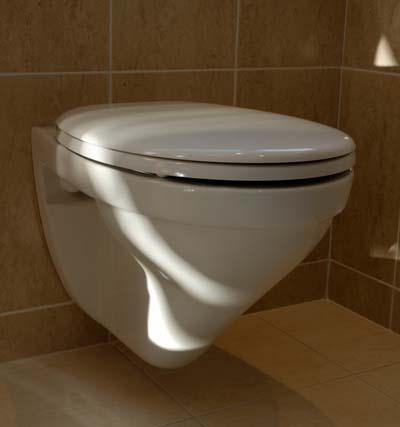If you’re in the market for a new home or renovating a bathroom, choosing the right toilet is important. Whether it is size, model, height, function, position, material, efficiency these are all factors to consider.
Toilets generally are made of ceramic but can also be available in stainless steel, plastic and porcelain. Different manufacturers would also have a variety of colour options.
Ensure that the new toilet is able to fit into the space of the old toilet. This can be done by knowing what the rough-in size is; this can be accomplished by measuring the distance between the wall and the centre of the drainpipe that holds the toilet to the floor. The standard rough-in size is between 10 -14 inches.

Toilets can be made as a one-piece, two-piece or wall mounted.
Traditionally toilets were made in two piece models, with a toilet bowl attached to the tank. This type of toilet is the most common and the parts are easy to find. The one-piece toilet is more expensive than the two-piece , however it saves space better and cleaning is easier. Wall mounted toilets can be more costly to purchase and install, it requires the drain hole to be on the wall instead of the floor. The wall would need to be strong for mounting.

Aside from the design of the toilet, considering where the flush lever handle would be located can add to the appearance of a toilet.
Some toilets come with a lever on the side, a push button located horizontally or vertically on the tank. As technology progresses, toilet flushing mechanism can be installed as sensors. This type of installation would require special material and increases the cost for installation and maintenance. The standard height for a toilet is 14 or 15 inches, however the 16 or 17 inch models are becoming increasingly popular. Choosing a toilet height can depend on the age, height, accessibility and personal preferences of the people living in the home.
Generally toilet bowls are available in two shapes – round and elongated (oval). Traditionally, most bowls were made in the round shape, this is generally a cheaper option and works well in a small space. Elongated bowls are usually 2 inches longer than the round shape and provide additional comfort.

Gravity Flushing System
Most types of toilets work the same, when you flush it the handle pulls up a chain which raises a valve and about two gallons of water is released into the bowl. Most people may think that the tank and its processing mechanism is the most important part of the toilet, however if you took the tank away and poured two gallons of water into the bowl the toilet would still flush. This is because most toilets are what is called “gravity toilets”, the water weight is the key factor used to facilitate a flush. This type of flushing system is the most common and simplest method; the pressure system forces everything down the bowl through the S-shaped trapway.
Pressure-Assisted Flush System
This flush system uses pressurized air to force the water into the bowl when flushed. It reduces the chances of clogs and it tends to be noisier than the gravity system. Pressure assisted flush system maintenance and overall repair costs are higher.
Dual Flush
Newer technology in the market has brought forward dual flush system. This flush system comes with two flush buttons, the first button is for flushing on a half tank while the other button is for a full flush. The upfront installation process can be expensive. Even though this system was designed to conserve water usage, toilets with single flush toilet can also achieve the same results.
Over the years manufactures have come a long way to improve the look, feel and efficiency of toilets. Low flow toilets are now designed to flush with 1.6 gallons of water rather than the traditional 3.5 gallons.
With all the above considerations in mind consumers should be prepared to choose the right toilet for their environment.
